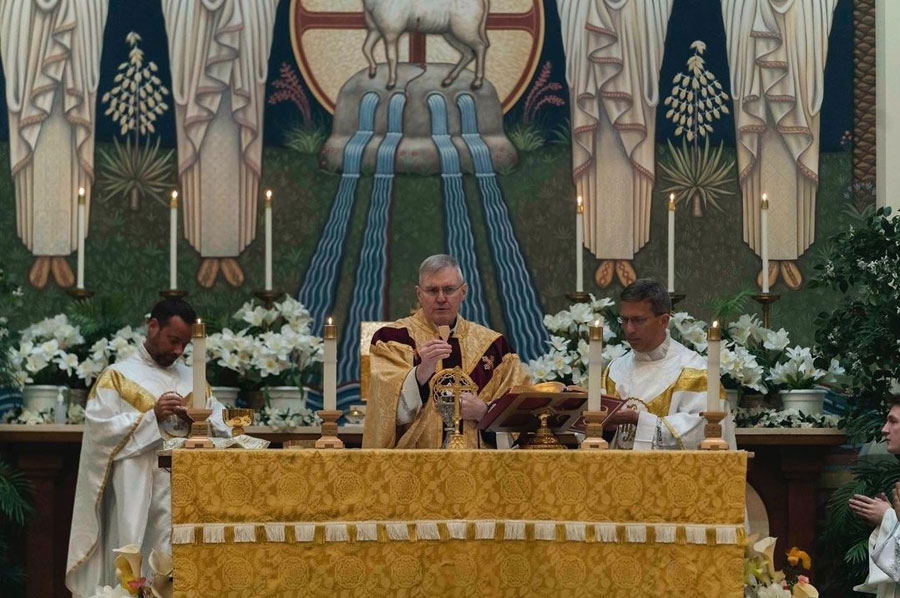
WELCOME TO THE NEWMAN CENTER!
As you explore our liturgical art pages, you'll notice these images are a reflection of our faith and tradition, and we hope they inspire you in your spiritual journey.
Art is a teaching tool, which is why we put art in the forefront of the church.
We are regularly asked about the art in our chapel and we felt this was the best way to not only showcase the art but to also educate visitors about this important part of our Catholic faith. If you are a student, faculty member, neighbor, parent or just visitor, thank you for taking the time to visit our church.
We invite you to stay connected with us by subscribing to our newsletter, following us on social media, or attending events.
May God bless you,
Fr. Rob Clement
Fr. Aaron Qureshi
Fr. Bruce Downs
3D VIRTUAL TOUR
Experience the All Saints Catholic Newman Center in immersive 3D. Utilize the interactive virtual tour, to navigate and explore our sacred space.
We have created an opportunity for you to take a virtual tour of The ASU Newman Center chapel and to learn more about the sacred art. By using 3D technology, you are able to walk through the church to enjoy and learn more about the art.
For Mobile and Phone Visitors:
Navigate by tapping and swiping, with pinch-to-zoom functionality for detailed views. Select areas of interest via the floor plan for direct access. Tap on the blue circles to get more detailed information about the art.
For Desktop Visitors:
Click and drag to pan, zoom in and out, and transition between rooms. Select specific areas via the floor plan for targeted viewing. Click on the blue circles to get more information about the art.
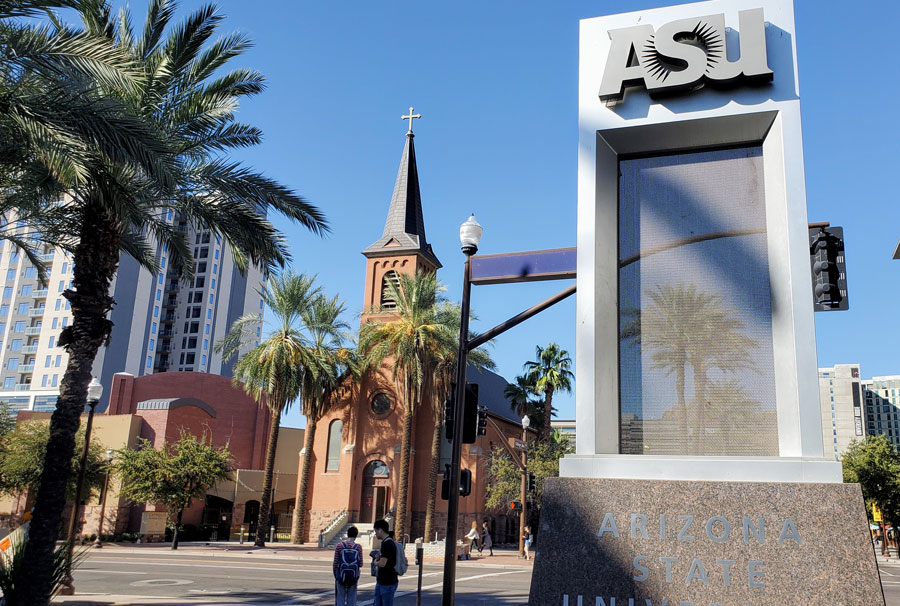
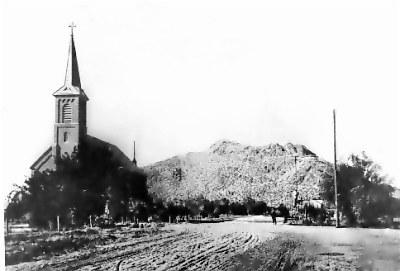
HISTORY OF THE ALL SAINTS CATHOLIC NEWMAN CENTER
The original St. Mary’s Church, today’s “old church,” was completed in 1903. The building was designed and built by Fr. Severin Westhoff, a German-born Franciscan priest who was the third pastor of the parish. Fr. Westhoff had no training in architecture or construction, so he hired two bricklayers from Tucson to build a church similar to the gothic style churches he remembered from growing up in Germany. Fr. Westhoff and the bricklayers went to the nearby Tempe barrios next to the Salt River and hired Catholic Yaqui Indians and Mexican immigrants to help with building the new church.
In 1932 the Newman Club was established on campus and operated out of the old church that had now become Our Lady of Mount Carmel parish. The Newman Club continued to grow and become a major part of campus life. In 1957, the parish broke ground at a new location in Tempe, and in 1962, Bishop Daniel Gercke, then bishop of the Diocese of Tucson (which at that time included most of Arizona), created the All Saints Catholic Newman Center on the property. In 1978, the old church was placed on the National Register of Historical Places.
As the growth of Arizona State University grew the Newman Center did as well. Today the Newman Center is the spiritual home to tens of thousands of students, faculty and staff of Arizona State University, Tempe residents and our mission supporters.
WHAT IS LITURGICAL ART?
The first commandment does not forbid imagery, but rather prohibits the worship of false gods or fashioning God in a way we find more pleasing. This distinction is evident in the biblical account following the reception of God's commandments.
A Catholic church is not simply a place in which we worship God… but with which we worship God. As such, it is often adorned with colorful vibrant imagery to “offer to the Lord a fitting place to worship Him” (cf. Isaiah 66:1).
When the Israelites rebelled against God and Moses (Exodus 32), they were afflicted by "saraph serpents" that caused many deaths (Numbers 21:6-7). God's remedy was to command Moses to "fashion a bronze serpent and place it on a pole," promising that "whoever shall look upon it shall be spared" (Numbers 21:9). This demonstrates that creating and using imagery is not inherently dishonorable to God, as the honor paid to such images is not idolatry, but rather a form of reverence.
The incarnation of Jesus Christ, the Son of God, further validates the use of imagery in worship. As "the visible image of the invisible God" (Colossians 1:15), Christ appeared among us in human form (Titus 3:4). Throughout His ministry, Jesus utilized tangible, visible elements of creation for healing and teaching. Even the Cross itself became a visible symbol of salvation. In this spirit, the Church employs visible images much as we keep photographs, paintings, and keepsakes of our loved ones on earth.
The Church's use of imagery stems from the human need for visual aids to belief. Sacred images offer numerous benefits to the faithful. They can be conduits for effective and sometimes supernatural graces, as evidenced by instances of miraculous pictures, statues, and crucifixes. These images help focus our attention during prayer, reducing distractions. They also serve as visual encouragements to emulate the virtues they depict. Furthermore, sacred art functions as an "excellent means for instructing the faithful in religion," transcending age and education levels through its universal visual language. It is worth noting that many of the world's greatest artists have been Catholic, creating masterpieces that predominantly feature religious subjects. Through these works, the Church continues to harness the power of visual representation to deepen faith and understanding among believers.
BEURONESE ART
The images you see in our Newman Center chapel are of a style of art developed by the monks of the Archabbey of Beuron in Baden-Wurttemberg, Germany. In the late 19th and early 20th centuries the Beuron Art School, with its emphasis on ancient art forms, in particular Byzantine art fused with Roman and Egyptian lines, was influential on religious art of the period. One of the biggest exhibits of this type of art in the United States is at Conception Abbey in Missouri, founded as a daughter house of the Archabbey of Beuron.
Windows into heaven is often how Christian iconography is described. Beuronese iconography is not as stark and esoteric as is eastern Christian icons. Beuronese style is more accessible to the Roman mind because of its textured dimensions, development of scenes and use of color, often depicting plants, even animals in the landscape. Another signature element of Beuronese Art is to include a brief verse from scripture in the background somewhere.
Fr. Rob Clements commissioned Ruth Ristow-Stricklin in 2011 to prepare and execute the first phase of panels which were the Christ Pantocrator, the Day of Pentecost and the Betrothal of the Blessed Virgin Mary to St. Joseph. He commissioned her again to complete the next phase of art for the chapel which you see here today. This was installed in December 2023.
We now devotedly display and offer to the community here at ASU. These spectacular icons are actually painted on canvas and then affixed to the wall utilizing a practice first developed during the time of the Greeks.. Eventually, all the wall space will be covered in such iconography, making the Life of the Lord Jesus, His Mother, and scenes from the Gospels come alive!
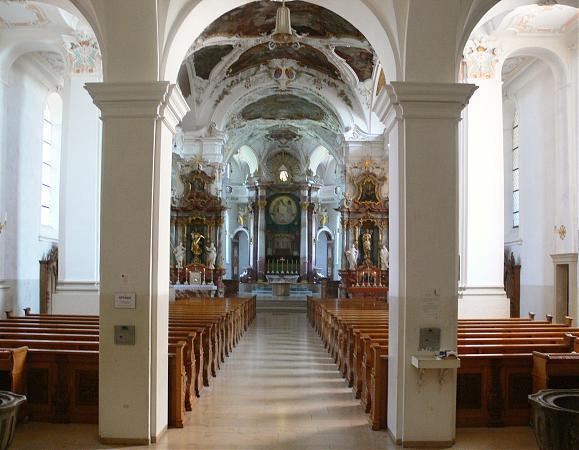
THE ART OF OUR SANCTUARY
The program of artwork in the sanctuary as a whole presents the eschatological (end of time) image of Christ "coming with the clouds of heaven, one like a son of man..." Daniel 7:13. In Revelation John gives us a similar vision of the end times... "a new heaven and a new earth," Rev. 21. The details of these passages are expressed in different aspects and details of the artwork.
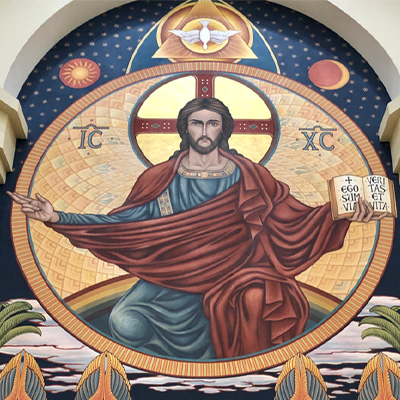
CHRIST PANTOCRATOR
This is the main image located directly behind the main altar. It depicts the Lord Jesus Christ, seated upon the cherubim, coming in glory at the end of time. One Hand is extended in blessing, and the other hold the Book of Life in which our names are to be inscribed. Rendered in Latin is the inscription (John 14:6): I AM the Way, the Truth, and the Life.
The artist has made use of an ancient technique in her version of the Pantocrator (Judge of the Living and the Dead). It’s found in the Eyes of Our Lord: one is the Eye of Mercy, the other the Eye of Scrutiny or Judgment. Stand at the back of the Chapel… Our Lord seems as if He’s almost frowning: we note more the Eye of Scrutiny. The closer we come to the front, we begin to notice that Our Lord is actually smiling: we note more the Eye of Mercy.
Much of the imagery – the angel choir, the river that flows through the City of God – is derived from the Book of Revelation. The Lamb Who was slain now lives! The River of God flows into the tabernacle where the Blessed Sacrament is housed. The words of St. John the Baptist are utilized above in the Latin (John 1:29): Behold the Lamb of God Who takes away the sins of the world.

THE DIVINE LAMB AND THE ANGELS
The Divine Lamb takes center stage in the apsidal mosaic, standing proudly on the mystic mount. From this sacred site, the four rivers of Paradise flow, representing the four Evangelists who share the Gospel's transformative power with humanity.
The Angels
The angels in this depiction are inspired by Revelation 8:3-4, where John envisions angels surrounding God's throne, offering incense that represents the prayers of the saints. These angels are not generic beings, but unique creations of God, just like human beings. This individuality is reflected in their luminous white attire, which symbolizes their distinct nature.
The subtle intricate patterns on each angel's garment represent the perfection and harmony of God's creation, which will be fully restored at the end of time. Each pattern signifies the diversity of our ASU Newman community, which encompasses various geographical areas, including Native American, Middle Eastern, African, Asian, European, Latin American, Russian, and Slavic cultures. The unique patterns on each angel's garment serve as a visual representation of the university’s rich cultural tapestry.

THE FOUR SYMBOLS OF THE GOSPELS
Each Evangelist is accompanied by a symbolic representative: Matthew by a man or angel, Mark by a lion, John by an eagle, and Luke by an ox. These symbols originate from the cherubim in Ezekiel's vision (Ezekiel 1:10) and John's vision in Revelation (Revelation 4:7), which describe four living creatures surrounding God's throne with faces of a man, lion, ox, and eagle.
Bishop Irenaeus of Lyons (2nd century) interpreted this fourfold pattern as a sign that God ordained four Gospels to describe the incarnation of Christ. He reasoned that just as there are four zones of the world, four principal winds, and four pillars of the Church, there should be four Gospels, each representing a different aspect of Christ's life.
The term "tetramorph" describes the symbolic arrangement of these four elements, derived from the Greek words "tetra" (four) and "morph" (shape). In Christian art, the tetramorph represents the union of the Evangelists' symbols, often depicted as a single figure or group of four figures.
Each Evangelist is associated with one of the living creatures, typically shown with wings. The traditional associations are: Mark with the lion (emphasizing Christ's royal dignity), Luke with the ox (highlighting the sacrificial nature of Christ's ministry), Matthew with the angel (representing Jesus' human descendants), and John with the eagle (symbolizing his heavenly visions). These symbols are commonly used in Evangelist portraits and depictions of Christ in Majesty.
THE SANCTUARY CEILING
Five ceiling panels of geometrically perfected stars and decoration remind us that our world is destined for healing and restoration. In the Mass we also look forward to the restoration of the entire cosmos, “a new heaven and a new earth,” (Rev. 21:1). A symbolic portrayal of the Blessed Trinity reminds us of the central reality of heaven and the dynamic direction of our liturgical prayers - to the Father, through the Son, in the power of the Holy Spirit.
Three six-winged seraphim, the angels closest to the throne of God, (Isaiah 6:3) are also portrayed. In Catholic churches, starry skies represent the perfect order of heaven. The depiction of stars on the ceilings brings the heavens, the Kingdom of God, closer to the worshipers.
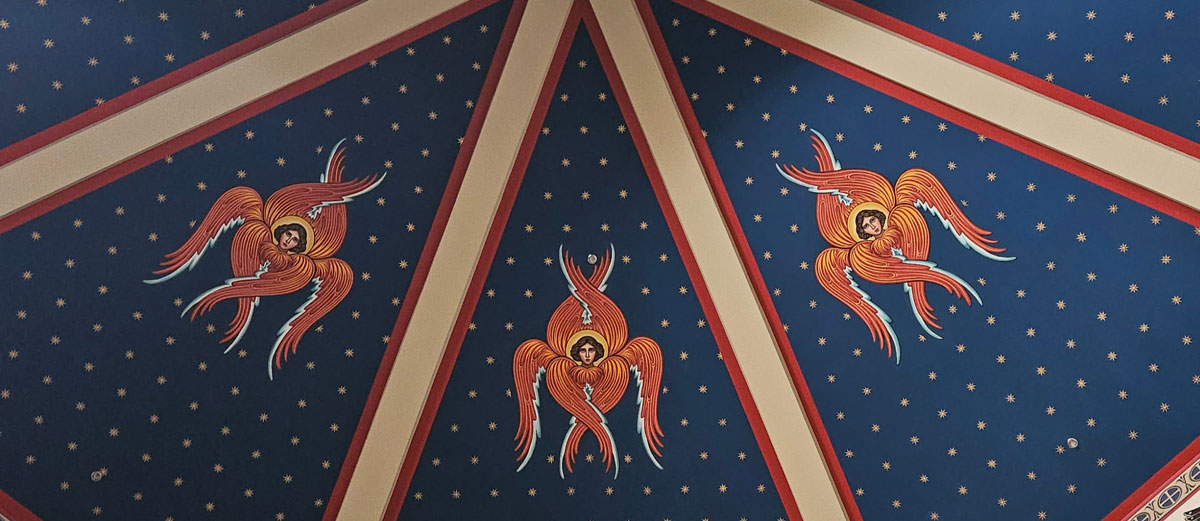
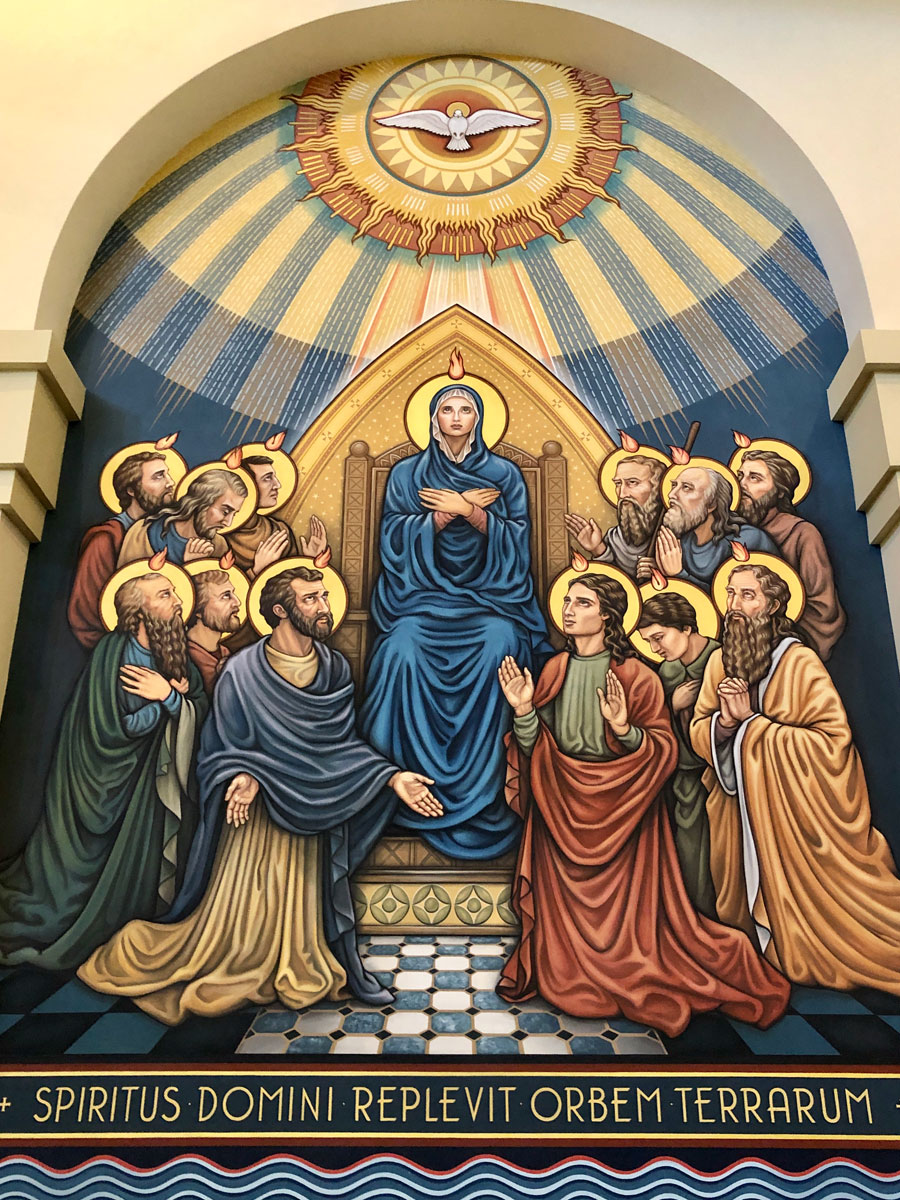
THE DAY OF PENTECOST
The image immediately to the right as one faces the main altar is a scene from the Acts of the Apostles (Acts 1:12-14; 2:1-4): the Sunday of Pentecost, when the Holy Spirit appeared visibly as in countless tongues of fire and rested upon the Blessed Virgin and the Apostles. This same Spirit is given to us sacramentally in Confirmation. Cited in the inscription is a scripture antiphon that’s been used at Mass on the Day of Pentecost since the 3rd century (Wisdom 1:7): The Spirit of the Lord fills the whole world.
THE BETROTHAL OF THE BLESSED VIRGIN MARY TO ST. JOSEPH
The image immediately to the left as one faces the main altar is a scene from the Gospel of St. Luke (Luke 1:26-28), which is cited in the Latin inscription: A man named Joseph [was betrothed to a virgin]… and the Virgin’s name was Mary. The Jewish priest from the Temple in Jerusalem – St. Simeon – witnesses the Betrothal (engagement leading to marriage) of the Blessed Virgin Mary to a widower – St. Joseph – of the House of David. Christian tradition holds that it was Simeon who arranged the marriage, as he had discerned that Our Lady was to be the vessel through whom God would take flesh and appear among us. Joseph it is who will serve as Protector of the Holy Family and foster-father to Our Lord Jesus Christ.
What is college but often a time in life when we discern our vocation, which for most of us is marriage – sometimes meet our spouses; grow in wisdom and faith and love.
A student asked me once to explain the words at the base of the Betrothal panel. There was a virgin betrothed to a man named Joseph… and the Virgin’s Name was Mary. “How come there in Latin?” Well, there’s close to 400 dialects spoken by the Student Body at ASU, every corner of the globe. Latin’s the language of the Church… a language that is the base of most modern languages in the western world… but the possession of no one nation or people.
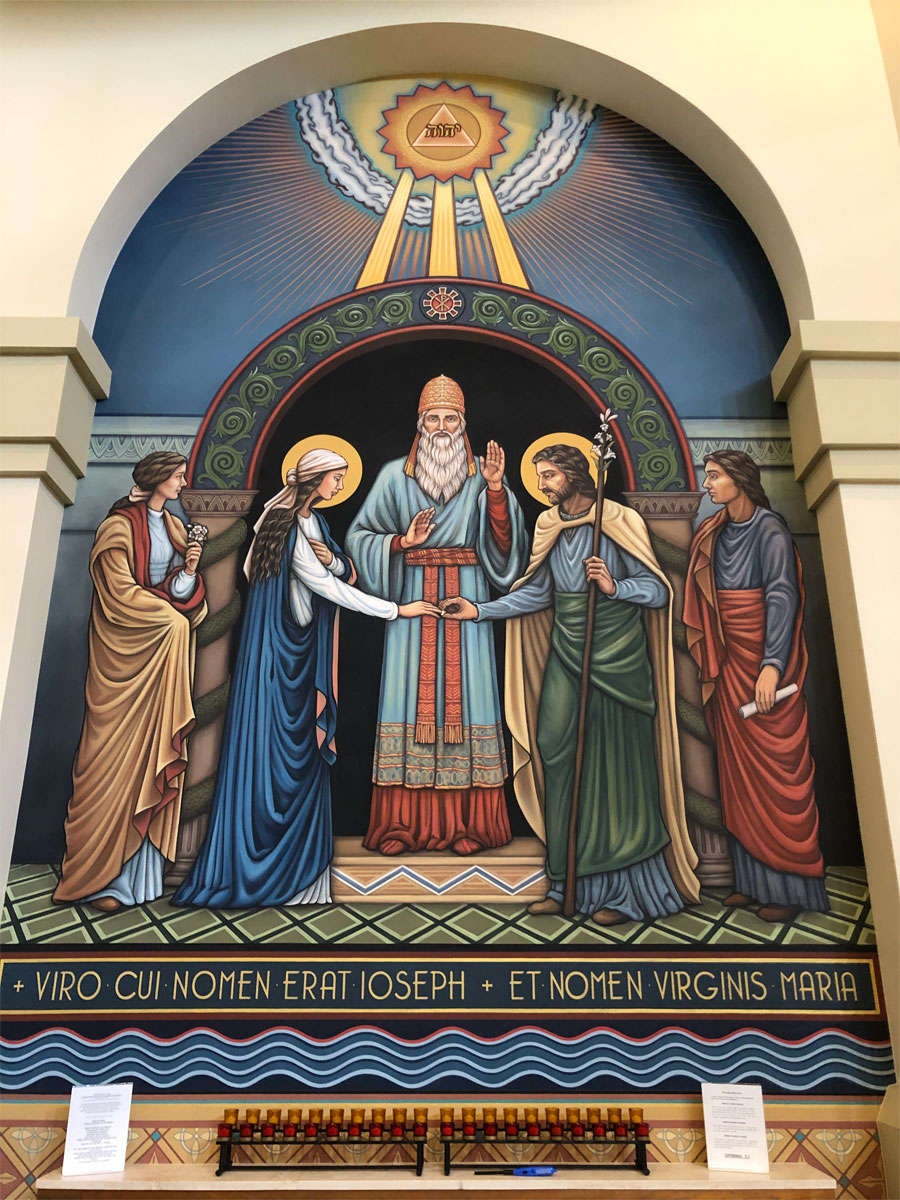
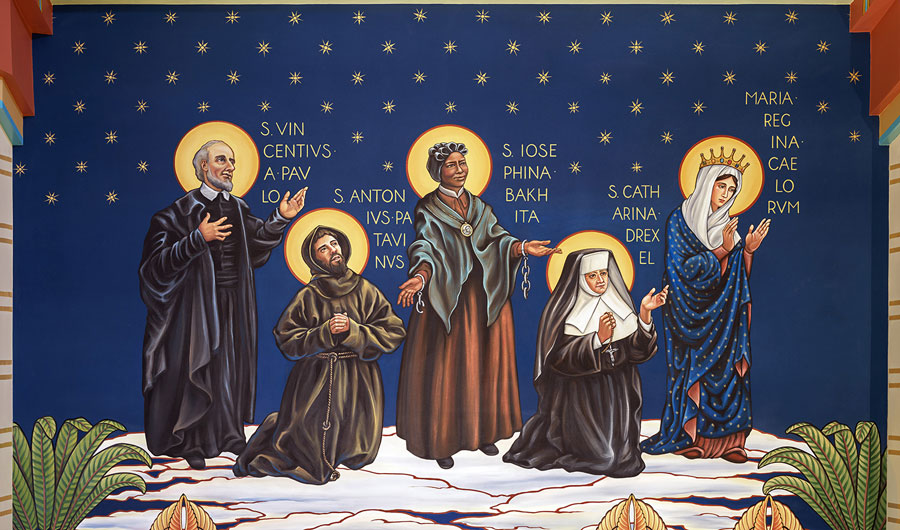
THE SAINTS (LEFT PANEL)
St Vincent de Paul
St. Vincent de Paul was born in 1581 and died in 1660, leaving behind a legacy of compassion, service, and dedication to the poor. As a young priest, he was captured by pirates and sold into slavery, but he never lost faith and eventually escaped. His experiences sparked a lifelong commitment to serving the marginalized, inspiring young adults to live a life of purpose and meaning.
St. Vincent's tireless work with the poor, sick, and imprisoned shows young people the importance of putting their faith into action. He also worked to promote education and spiritual formation among university students, founding the Congregation of the Mission to provide spiritual direction and training for priests and laity. Through his example, he encourages young adults to be bold in their service, humble in their leadership, and generous in their love. As the founder of the Vincentians, St. Vincent de Paul remains a powerful role model for young adults seeking to make a difference in the world.
St. Anthony of Padua
St. Anthony of Padua was born in 1195 in Lisbon, Portugal, and died in 1231 in Padua, Italy. He was a Franciscan friar and priest who became famous for his powerful preaching, his ability to perform miracles, and his deep understanding of Scripture. St. Anthony's life was marked by a desire to serve the Lord and to spread the Gospel message to all people. He was particularly devoted to the poor, and he worked tirelessly to help those in need.
St. Anthony's importance to young people lies in his example of living a life of purpose and meaning. He was a brilliant student and teacher, and he taught theology at the University of Padua, where he became known as the "Hammer of Heretics" for his ability to refute false teachings. Through his example, St. Anthony encourages young people to pursue their passions, to develop their talents, and to use their gifts to serve others. He is also the patron saint of lost things, and is often invoked by students seeking help with their studies. As a model of compassion, wisdom, and faith, St. Anthony of Padua remains a powerful inspiration for young people around the world.
St. Josephine Bakhita
St. Josephine Bakhita was born in 1869 in Sudan and was kidnapped into slavery, but later found freedom in Christ, becoming a Canossian Sister and a beacon of hope for the marginalized. Her remarkable journey from slavery to sainthood inspires young adults to trust in God's providence and find strength in adversity. St. Josephine's witness shows that even in the darkest situations, faith, forgiveness, and love can triumph.
Her humility, kindness, and generosity encourages all of us to live a life of service and compassion. She was canonized by Pope John Paul II on October 1, 2000, and through her example, St. Josephine empowers young adults to overcome their own struggles and find purpose in serving others.
St. Katherine Mary Drexel
St. Katharine Drexel was a pioneering American saint who dedicated her life to serving Native Americans and African Americans, founding the Sisters of the Blessed Sacrament in 1891. With a deep love for the Gospel and a strong sense of justice, she established schools, missions, and hospitals across the United States, including St. Michael’s Indian School in St. Michaels, Arizona. Many graduates of St. Michaels have attended ASU and have been a part of the Newman Center.
Her selfless service and advocacy for the rights of the less fortunate inspire young adults to embrace their own call to discipleship and work towards a more just society. Through her example, St. Katharine shows young adults that they too can make a difference in the world by living a life of faith, compassion, and service. As a champion of education, St. Katharine Drexel remains a powerful role model for young adults seeking to live out their values and make a positive impact on the world.
Mary, Queen of Heaven
Mary, the Mother of God, is the ultimate example of faith, obedience, and trust in God's plan. As a young woman, she surrendered her life to God's will, becoming the mother of Jesus Christ and the Queen of Heaven. Her selflessness, humility, and courage inspire young adults to live a life of surrender, trust, and service to others. Mary's yes to God's plan shows young people that their own fiat can change the world.
As a model of purity, kindness, and compassion, Mary guides young adults towards a life of virtue and holiness. Through her intercession, Mary, Queen of Heaven, empowers young adults to become instruments of God's love and mercy in the world. With her guidance, young adults can navigate life's challenges with confidence and hope, knowing they are not alone. By following Mary's example, college students can become a reflection of God's love, shining brightly for all to see.
THE SAINTS (RIGHT PANEL)
St. Joseph
St. Joseph was a righteous and faithful man, chosen by God to be the earthly father of Jesus Christ, and his example of humility, obedience, and devotion makes him a powerful role model for young people. As a guardian and protector of Mary and Jesus, Joseph showed remarkable trust and faith, demonstrating to young people the importance of surrendering to God's will. His quiet strength and leadership as the head of the Holy Family inspire young people to embrace their own vocations and responsibilities with courage and confidence.
Joseph's patience and understanding in the face of uncertainty and adversity offer a reassuring example to young people navigating their own challenges and doubts. As the patron saint of families, workers, and the universal Church, St. Joseph intercedes for young people, guiding them towards their own path of discipleship and holiness. Through his example and intercession, St. Joseph helps all of us discover our own unique role in God's plan and empowers them to live a life of purpose, integrity, and faith.
St. Catherine of Siena
For 42 years, the Dominican Order staffed our Newman Center. It is essential for us to acknowledge their efforts and commitment to the university. St. Catherine of Siena (1347-1380) was a lay Dominican mystic and theologian who advocated for Church reform and spiritual renewal. She served the poor and promoted God's love through her writings and mystical experiences.
She helped bring about a spiritual revival and is now recognized as a Doctor of the Church. Her legacy inspires devotion and service and she remains a revered model of Dominican ideals.
St. Andrew Kim
St. Andrew Kim Taegon was a courageous and zealous young priest who became Korea's first native-born Catholic priest in 1845, at the age of 24. With a deep love for his people, Fr. Kim bravely evangelized Korea, spreading the Gospel despite fierce persecution. His youthful passion and cultural sensitivity inspired many to embrace the faith, making the Gospel message resonate with his fellow Koreans.
Arrested and tortured for his beliefs in 1846, Fr. Kim remained steadfast in his faith, offering a powerful witness to the Gospel. His martyrdom at 25 has made him a powerful intercessor and model of holiness, inspiring young Catholics to courageously live out their faith. Canonized by Pope John Paul II in 1984, St. Andrew Kim is revered as the patron saint of Korea, inspiring young adults around the world with his courage, compassion, and unwavering commitment to his faith.
Blessed Chiara Badano
Blessed Chiara Badano is one of two “Blesseds,” not yet canonized, that are adorned in the chapel. She was born on October 29, 1971, in Sassello, Italy, to a devout Catholic family. She was a vibrant and faith-filled young woman who lived a life of joy, love, and service to others. Diagnosed with a rare bone cancer at 16, Chiara embraced her suffering with courage and trust in God, offering her pain for the salvation of souls.
Her remarkable witness to the Gospel inspires young adults to live their faith with authenticity and passion. Chiara's love for life, her friends, and her family shows young people that faith and joy are not mutually exclusive, but intertwined. As a patron for young people, Chiara intercedes for them, guiding them towards a life of purpose, hope, and holiness. She died in 1990 when she was just 19 years old and was beatified in 2010 by Pope Benedict XVI.
Blessed Piergiorgio Frassatti
Blessed Pier Giorgio Frassati is the other “Blessed” in our chapel. He was born on April 6, 1901, in Turin, Italy. Despite his privileged upbringing, Pier Giorgio dedicated his life to serving the poor and marginalized, inspired by his devout Catholic faith. He was a third order Dominican, and an active member of the St. Vincent de Paul Society. Blessed Pier Giorgio and spent much of his time volunteering at a local hospital and serving the needy.
Blessed Pier Giorgio's deep love for sports, nature and the outdoors also led him to become an avid mountain climber, earning him the nickname "Verso l'alto" ("Towards the top"). Tragically, his life was cut short when he died of polio on July 4, 1925. At his funeral, his casket was carried through the streets of Turin where thousands of the city’s poor lined the streets and spread flowers before him. His deep faith, service to others, intellectual curiosity, joyful living, and courage and resilience inspire young adults today. He was beatified by Pope John Paul II in 1990.
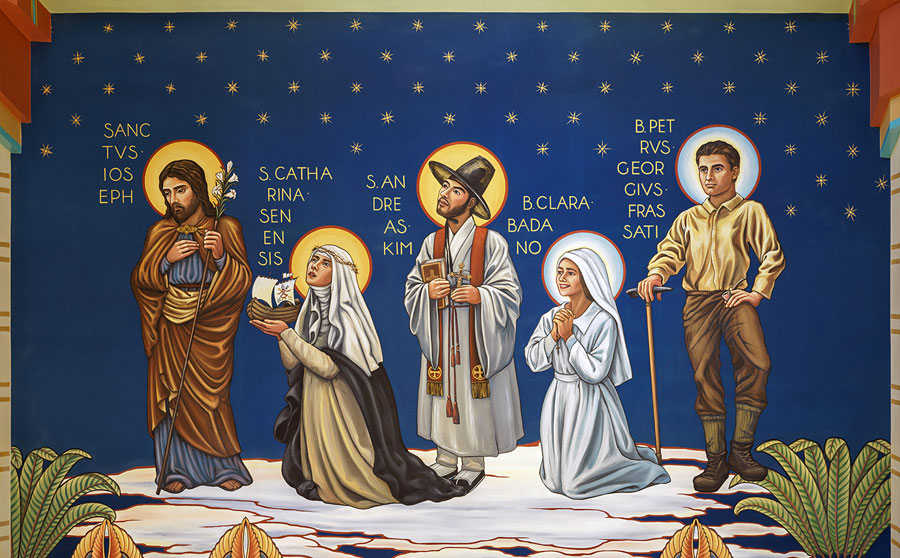

THE ROOD SCREEN
The rood screen, a significant element in Western Christian architecture of the Middle Ages and early Renaissance, served to separate the chancel (the area around the altar) from the nave (the area set apart for the laity). This architectural feature, known as a templon in Italy and often referred to as a "Rood Beam" in England, is closely associated with the rood, an Old English term for "cross" or "crucifix." The beam, supported by two pillars, marks off the sanctuary and serves as a decorative element displaying the Crucifix. It also "houses" the altar, similar to a baldacchino (a canopy supported by four pillars) found in many churches. This architectural feature has its roots in Jewish Temple practices described in the Old Testament.
The rood screen often bears inscriptions of religious significance. Here at the Newman Center, the words depicted on the beam are taken from the Book of Revelation in the New Testament: "With Your Blood, Lord, you purchased for God a people of every tribe, tongue and nation." This passage is particularly fitting for a university setting, as it emphasizes the diversity and unity of people from various backgrounds. The quote continues, "and have made them priests to serve our God," further emphasizing the sacred nature of this architectural element and its role in delineating the holy space within the church.
THE STAINED GLASS WINDOW IN THE CHOIR LOFT
In the back of the chapel, above the loft, is the stained glass window depicting the Blessed Mother of God, and utilizes a style reminiscent of 15th century practice. Our beloved “Old Church” was the first Catholic church in the Valley dedicated to the Blessed Virgin Mary, so it’s intended as something as a connector of “old with new.” This window is the gift of Dr. & Mrs. Peter Labadie as a memorial to Dr. William L. and E. Ursula Labadie.
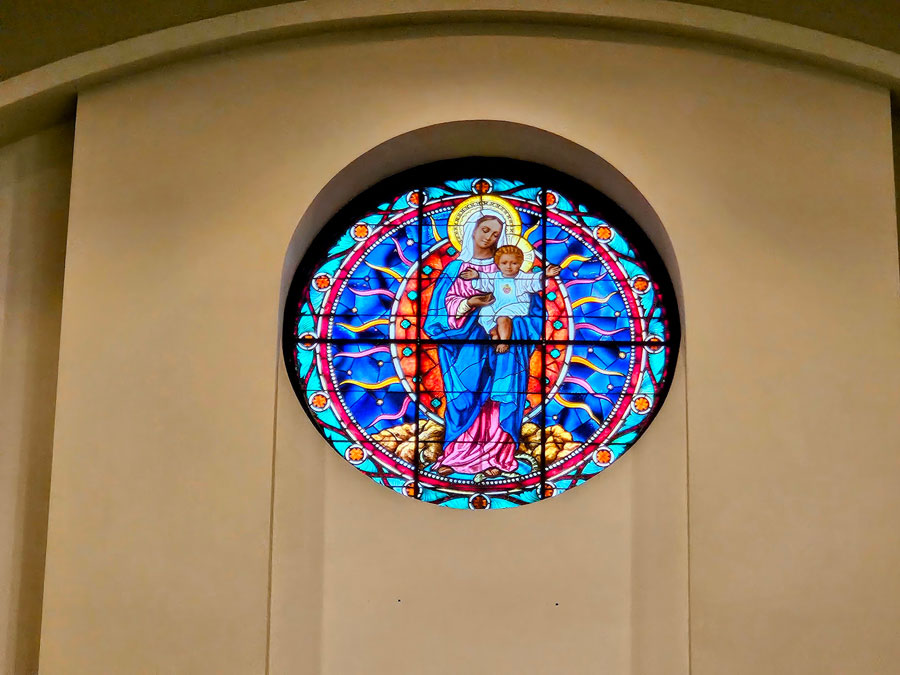
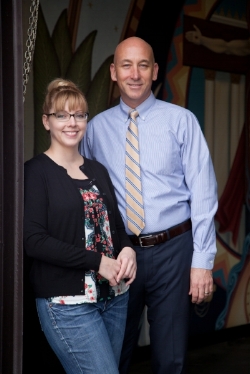
THE ARTIST: RUTH STRICKLIN
Artist Ruth Stricklin experienced a profound conversion to the Catholic faith through an encounter with beauty in sacred art and music in the liturgy, which she came to understand were encounters with Christ himself. Ruth pursued further studies at the Liturgical Institute, Mundelein, IL, where she discovered her true vocation as a sacred artist. Together with her husband Geoff, also a graduate of the Liturgical Institute, they founded New Jerusalem Studios in 2014 to proclaim the gospel through radiantly beautiful sacred art and design.
Their work has been showcased by the United States Conference of Catholic Bishops (USCCB), used at the 2024 National Eucharistic Congress in Indianapolis, and installed in parishes and Catholic schools throughout the United States.